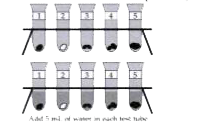Small pieces of steel and some powdered rust are taken in two test tubes separately. What will you obseve when concentrated hydrochloric acid is poured into both the test tubes ? Justify your observation.
Step-by-Step Solution:
1. Identify the Materials: We have two test tubes. One contains small pieces of steel and the other contains powdered rust (iron oxide).
2. Add Concentrated Hydrochloric Acid: We will pour concentrated hydrochloric acid (HCl) into both test tubes.
3. Observation with Steel:
- When concentrated hydrochloric acid is added to the small pieces of steel, a chemical reaction occurs.
- Steel, primarily composed of iron, reacts with hydrochloric acid to produce iron chloride and hydrogen gas.
- The reaction can be represented by the equation:
Fe (s) + 2 HCl (aq) → FeCl2 (aq) + H2 (g)
- As a result, you will observe effervescence (bubbles) due to the liberation of hydrogen gas.
4. Observation with Powdered Rust:
- When concentrated hydrochloric acid is added to powdered rust (iron oxide), the reaction is different.
- Rust (Fe₂O₃ or Fe₃O₄) reacts with hydrochloric acid to form iron chloride and water, but it does not produce hydrogen gas in the same manner as steel.
- The reaction can be represented by the equation:
Fe2O3 (s) + 6 HCl (aq) → 2 FeCl3 (aq) + 3 H2O (l)
- In this case, you will not observe effervescence because hydrogen gas is not released in significant amounts.
5. Justification of Observations:
- The difference in observations is due to the chemical nature of the materials. Steel, being primarily iron, reacts vigorously with hydrochloric acid, releasing hydrogen gas and causing effervescence.
- In contrast, powdered rust (iron oxide) reacts with hydrochloric acid to form iron chloride and water without liberating hydrogen gas, hence no effervescence is observed.
- When concentrated hydrochloric acid is added to the small pieces of steel, a chemical reaction occurs.
- Steel, primarily composed of iron, reacts with hydrochloric acid to produce iron chloride and hydrogen gas.
- The reaction can be represented by the equation:
Fe (s) + 2 HCl (aq) → FeCl2 (aq) + H2 (g)
- As a result, you will observe effervescence (bubbles) due to the liberation of hydrogen gas.
- When concentrated hydrochloric acid is added to powdered rust (iron oxide), the reaction is different.
- Rust (Fe₂O₃ or Fe₃O₄) reacts with hydrochloric acid to form iron chloride and water, but it does not produce hydrogen gas in the same manner as steel.
- The reaction can be represented by the equation:
Fe2O3 (s) + 6 HCl (aq) → 2 FeCl3 (aq) + 3 H2O (l)
- In this case, you will not observe effervescence because hydrogen gas is not released in significant amounts.
- The difference in observations is due to the chemical nature of the materials. Steel, being primarily iron, reacts vigorously with hydrochloric acid, releasing hydrogen gas and causing effervescence.
- In contrast, powdered rust (iron oxide) reacts with hydrochloric acid to form iron chloride and water without liberating hydrogen gas, hence no effervescence is observed.
Topper's Solved these Questions
- NATURE OF MATTER BOOK - PEARSON IIT JEE FOUNDATIONCHAPTER - NATURE OF MATTER EXERCISE - LEVEL 3
10 Videos
- NATURE OF MATTER BOOK - PEARSON IIT JEE FOUNDATIONCHAPTER - NATURE OF MATTER EXERCISE - LEVEL 1
45 Videos
- METALS AND NON-METALSBOOK - PEARSON IIT JEE FOUNDATIONCHAPTER - METALS AND NON-METALSEXERCISE - Level-3 Concept Application
10 Videos
- Organic ChemistryBOOK - PEARSON IIT JEE FOUNDATIONCHAPTER - Organic ChemistryEXERCISE - Level 3
9 Videos
Similar Questions
Write two observations when lead nitrate is heated in a test tube.
View SolutionEqual amounts of sodium hydrogencarbonate are taken in two test tubes A and B. Acetic acid is added to test-tube A whereas an equal volume of hydrochloric acid is added to test-tube B. In which test-tube, effervescence will occur more vigorously and why?
View Solution
Knowledge Check
When dilute hydrochloric acid is added to zinc pieces taken in a test tube
Ano change takes placeBthe colour of the solution becomes yellowCa pungent smelling gas gets liberatedDsmall bubbles of hydrogen gas appear on the surface of zinc pieces.When dilute hydrochloric acid is added to granulated zinc placed in a test tube, the observation made is:
AThe surface of the metal turns shiningBthe reactioin mixture turns milkyCordour of chlorine is observedDa colourless and odourless gas evolves with bubblesSome materials like magnesium ribbon, aluminium foil, copperr wire and charcoal (powder) were taken in different test tubes labelled as P, Q, R and S. 5 mL of dilute hydrochloric acid was added to each test tube. When a burning matchstick is brought near the mouth of each test tube, in which cases pop sound would be heard ?
AOnly PBOnly P and QCOnly Q and SDOnly P, Q and R
In a chemistry lab, Rina took some mercury and water in two test tubes separately. Then she drained off both the liquids and on observing the emty test tubes, found some difference. Can you guess what the difference is ? Explain with appropriate reasons.
View SolutionWhat happens when a small amount of baking soda is taken in a test tube and some dilute hydrochloric acid is added to it ?
View SolutionA small amount of copper oxide is taken in a test tube and dilute acid is added to it with stirring. Which colour will be obtained in the test tube ?
View SolutionMona tries an experiment with five different metals namely sodium, magnesium, zinc, iron and copperr taken in five different test tubes respectively.

Mona observed that hydrogen gas is evolved in test tube 3, only when it was boiled. test tube 3 contains only ____
View SolutionWhen dilute sulphuric acid is added to granulated zinc placed in a test-tube, the observation made is :
View Solution
